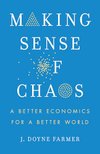
Saved by Ken Karakotsios
Making Sense of Chaos: A Better Economics for a Better World

Saved by Ken Karakotsios
Complex systems like the brain or an ant colony are called adaptive complex systems. They are distinguished from ordinary complex systems with simpler emergent behaviors by the fact that their properties have evolved over time, through a process of selection. Consciousness doesn’t emerge by simply hooking up neurons at random; they have to be
... See moreWith an appropriate effort, we could build much more accurate agent-based models in five years or less, which could give us invaluable guidance in negotiating the climate-driven transition of the economy and other global problems that depend on economics.
But because nonlinear dynamics is a prerequisite for endogenous dynamics – that is, motion from within – linearizing the equations makes it impossible for dynamics to emerge.
Some of the parameters are easy to pin down, like a tax rate, which you simply look up. Other parameters may not be so straightforward to set; we call these free parameters. Our model had quite a few of them.
When the social-interaction time is short, the economy gets stuck in a poverty trap, where the average savings rate and household consumption are very low.
only 35 per cent of the improvements in a typical industry come from within the industry itself.
Later I found out that Markowitz himself knew the same thing: Ironically, when he invested the money from his Nobel Prize, he used a portfolio with equal weights to pick a few of his favorite stocks rather than the formula he received the prize for discovering.
To make the green-energy transition rapidly and cheaply, we need reliable models, based on empirical data, that allow us to predict the likely outcomes of each possible course of action.
Because people don’t follow simple mechanical rules, modeling human decision-making is an even bigger challenge. Understanding how people make decisions, both as individuals and in groups, is an important goal of the disciplines of psychology, sociology, anthropology and political science.